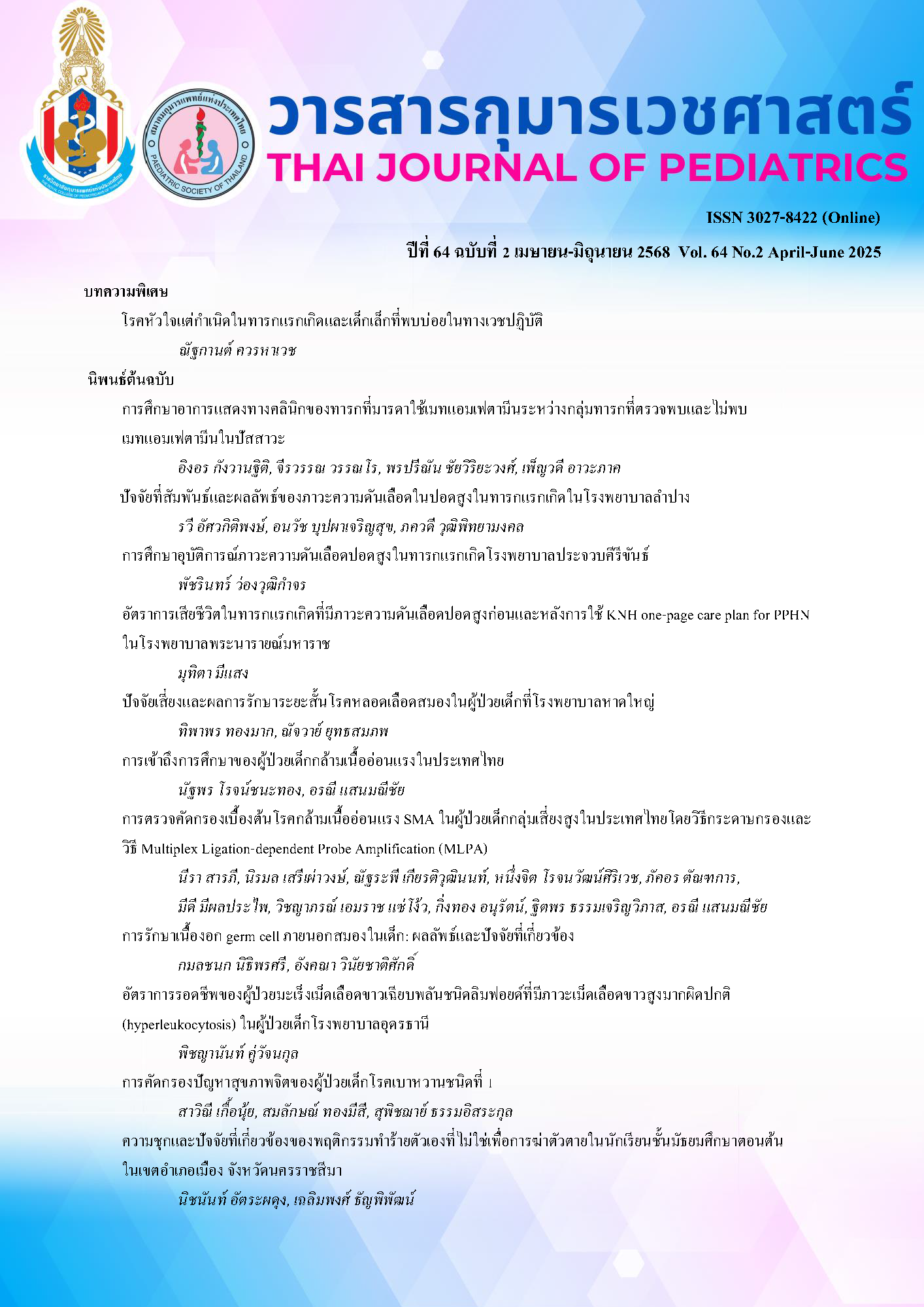การคัดกรองปัญหาสุขภาพจิตของผู้ป่วยเด็กโรคเบาหวานชนิดที่ 1
คำสำคัญ:
โรคเบาหวานชนิดที่ 1 ในผู้ป่วยเด็ก, สุขภาพจิต, แบบประเมินจุดแข็งและจุดอ่อนบทคัดย่อ
ความเป็นมา: โรคเบาหวานชนิดที่ 1 ในเด็กและวัยรุ่นมีอัตราเพิ่มสูงขึ้นร้อยละ 2-5 ต่อปีจากการศึกษาทั่วโลก เช่นเดียวกับในประเทศไทย ปัจจุบันพบมีผู้ป่วยแนวโน้มเพิ่มสูงขึ้นเป็น 1.27 ต่อ 100,000 ราย ในผู้ป่วยเด็กที่เป็นโรคเบาหวานชนิดที่ 1 พบมีปัญหาด้านสุขภาพจิตในภายหลังมากกว่าเด็กสุขภาพดี คิดเป็นร้อยละ 30.56 และ 15.56 ตามลำดับ ดังนั้นการศึกษาภาวะสุขภาพจิตในผู้ป่วยจะช่วยให้สามารถเข้าถึงปัญหาสุขภาพจิตได้รวดเร็ว นำไปสู่การรักษาแบบองค์รวมในผู้ป่วยเด็กโรคเบาหวาน
วัตถุประสงค์: เพื่อศึกษาภาวะสุขภาพจิตของผู้ป่วยเด็กโรคเบาหวานชนิดที่ 1 และปัจจัยต่างๆที่มีผลทำให้เกิดปัญหาสุขภาพจิตมากขึ้น
วิธีการศึกษา: เป็นการศึกษารูปแบบ cross-sectional descriptive study ในผู้ป่วยเด็กโรคเบาหวานชนิดที่ 1 อายุตั้งแต่ 4-16 ปีที่เข้ารับการรักษาในคลินิกต่อมไร้ท่อโรงพยาบาลชลบุรี เดือนตุลาคม พ.ศ.2566 - ตุลาคม พ.ศ. 2567 มีการเก็บข้อมูลทั่วไป ข้อมูลการเจ็บป่วยและการรักษาของผู้ป่วย และตอบแบบประเมินจุดแข็งและจุดอ่อน (Strengths and Difficulties; SDQ) คัดกรองปัญหาด้านพฤติกรรม/อารมณ์ โดยผู้ปกครองและเด็กประเมินเอง ใช้สถิติเชิงพรรณนา แสดงในรูปแบบค่าเฉลี่ย ส่วนเบี่ยงเบนมาตรฐาน หรือค่ามัธยฐานและร้อยละ, Chi-square test, Fisher’s exact test, linear regression analysis และ Pearson’s correlation
ผลการศึกษา: จากผู้ป่วยโรคเบาหวานชนิดที่ 1 จำนวณ 74 ราย มีอายุเฉลี่ย 10.6 ± 3.6 ปี ส่วนใหญ่เป็นเพศหญิงร้อยละ 55.4 เมื่อใช้แบบสอบถาม SDQ คัดกรองปัญหาด้านพฤติกรรม/อารมณ์โดยผู้ปกครองและเด็กอายุ 11-16 ปีประเมินตนเอง พบว่ามีปัญหาสุขภาพจิตร้อยละ 14.9 และร้อยละ 9.8 ตามลำดับ พฤติกรรมด้านความสัมพันธ์กับเพื่อนเป็นด้านที่มีปัญหามากที่สุด (ร้อยละ 36.5 และ 9.8 ตามลำดับ) ปัจจัยที่มีผลต่อปัญหาสุขภาพจิตในผู้ป่วยเด็กโรคเบาหวานชนิดที่ 1 คือการเป็นโรคเบาหวานที่เป็นมานานมากกว่าเท่ากับ 3 ปี
สรุป: การคัดกรองสุขภาพจิตด้วยแบบประเมิน SDQ พบว่าเด็กโรคเบาหวานชนิดที่ 1 มีความเสี่ยงต่อปัญหาทางอารมณ์และพฤติกรรม จึงควรเฝ้าระวังอย่างต่อเนื่อง
Downloads
เอกสารอ้างอิง
Onkamo P, Vaananen S, Karvonen M. Worldwide increase in incidence of type I diabetes-the analysis of the data on published incidence trends. Diabetologia. 1999;42:1395–403.
Gillespie KM, Bain SC, Barnett AH, Bingley PJ, Christie MR, Gill GV, et al. The rising incidence of childhood type 1 diabetes and reduced contribution of high-risk HLA haplotypes. Lancet. 2004;364:1699-700.
Gale EAM. The rise of childhood type 1 diabetes in the 20th century. Diabetes. 2002;51:3353–61.
International Diabetes Federation. Type 1 diabetes. [Internet]. 2020 [cited 2020 July 3]. Available from: https://www.idf.org/aboutdiabetes/type-1-diabetes.html.
Jaruratanasirikul S, Thammaratchuchai S, Sriplung H. Trends of childhood diabetes in Southern Thailand: 20-year experience in a tertiary medical center. World J Pediatr. 2017;13:566-70.
Trepatchayakorn S. Trends and characteristics of childhood diabetes in a tertiary care center in Thailand. Asian Biomed. [Internet]. 2015 [cited 2020 Dec 5]. Available from: https://www.semanticscholar.org/paper/Trends-and-characteristics-of-childhood -diabetes- in-Trepatchayakorn /152d6a2713a34147 c0e5abf708d011bcf6f5008a.
Deerochanawong C, Ferrario A. Diabetes management in Thailand: A literature review of the burden, costs, and outcomes. Global Health. 2013;9:11.
Almeida MC, Claudino DA, Grigolon RB, Fleitlich-Bilyk B, Claudino AM. Psychiatric disorders in adolescents with type 1 diabetes: a case-control study. Braz J Psychiatry. 2018;40:284-9.
Zenlea IS, Mednick L, Rein J, Quinn M, Wolfsdorf J, Rhodes ET. Routine behavioral and mental health screening in young children with type 1 diabetes mellitus. Pediatr Diabetes. 2014;15:384-8.
Boogerd EA, Damhuis AM, van Alfen-van der Velden JA, Steeghs MC, Noordam C, Verhaak CM, et al. Assessment of psychosocial problems in children with type 1 diabetes and their families: the added value of using standardised questionnaires in addition to clinical estimations of nurses and paediatricians. J Clin Nurs. 2015;24:2143-51.
Wongpiromsarn Y, Wipulakorn P, Nuanmanee S, Woerner W, Mongkol A. Strengths and Difficulties Questionnaire (SDQ) Thai improved version: change and administration. J Ment Health Thai. 2011;19:128–34.
Toh ZQ, Koh SSL, Lim PK, Lim JST, Tam W, Shorey S. Diabetes-related emotional distress among children/adolescents and their parents: A descriptive cross-sectional study. Clin Nurs Res. 2021;30:311-21.
Duffus SH, Cooper KL, Agans RP, Jain N. Mental health and behavioral screening in pediatric type 1 diabetes. Diabetes Spectr. 2019;32:171-5.
Stahl-Pehe A, Lange K, Bachle C, Castillo K, Holl RW, Rosenbauer J. Mental health problems among adolescents with early-onset and long-duration type 1 diabetes and their association with quality of life: a population-based survey. PLoS One. 2014;9:e92473.
Brodar KE, Davis EM, Lynn C, Starr-Glass L, Lui JHL, Sanchez J, et al. Comprehensive psychosocial screening in a pediatric diabetes clinic. Pediatr Diabetes. 2021;22:656-66.
Sassmann H, Kim-Dorner SJ, Berndt V, Biester T, Dehn-Hindenberg A, Heidtmann B, et al. Understanding daily, emotional, and physical burdens and needs of parents caring for children with type 1 diabetes. J Diabetes Res. 2022;2022:9604115.
Harrington KR, Shapira A, Volkening LK, Butler DA, Anderson BJ, Wasserman RM, et al. Associations of diabetes self-management characteristics, HbA1c, and psychosocial outcomes with depressive symptoms in a contemporary sample of adolescents with type 1 diabetes. J Diabetes Complications. 2021;35:107838.
Dogan B, Oner C, Akalin AA, Ilhan B, Caklili OT, Oguz A. Psychiatric symptom rate of patients with diabetes mellitus: A case control study. Diabetes Metab Syndr. 2019;13:1059-63.
ดาวน์โหลด
เผยแพร่แล้ว
รูปแบบการอ้างอิง
ฉบับ
ประเภทบทความ
สัญญาอนุญาต
ลิขสิทธิ์ (c) 2025 ราชวิทยาลัยกุมารแพทย์แห่งประเทศไทย และ สมาคมกุมารแพทย์แห่งประเทศไทย

อนุญาตภายใต้เงื่อนไข Creative Commons Attribution-NonCommercial-NoDerivatives 4.0 International License.


